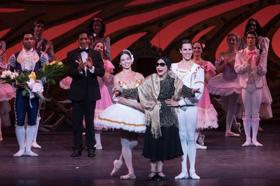Review: Historic Return of the BALLET NACIONAL DE CUBA at the Kennedy Center

It was 40 years ago this week that the Ballet Nacional de Cuba made its historic U.S. debut at the Kennedy Center. There, the remarkable Alicia Alonso was not only artistic director but star performer, who became a ballet force at the American Ballet Theatre and elsewhere despite an eye condition she had since a teenager that caused partial blindness.
At the time of the company's U.S. debut, she was quite old to be on stage, 57. But what's amazing about the Ballet Nacional de Cuba's return to the Kennedy Center this week - its first appearance since 2011 - is that she is still there, at 97, as artistic director and choreographer of the two works in repertoire, Don Quixote and Giselle, the piece that brought early fame to Alonso in 1943.
So following a short film before the dancing marks the anniversary of the company's landmark U.S. debut, and celebrates its current return, representing the climax of the Kennedy Center's month-long Artes de Cuba: From the Island to the World festival, the spotlight turns to the amazing Alonso in the trustees box - shunken somewhat as she approaches 100, with huge sunglasses and a fancy headress, nodding, waving and eventually doing some fluid arm waves as a way to show she still has it. Altogether, it's a moment you wonder can be ever topped by what's on stage.
It is, however, in a vibrant Don Quixote in which Cervantes' star creation pads through the action with his sidekick Sancho Panza, serving more as a romantic inspiration than central figure of the story of a young woman who falls in love with a barber, eschewing her father's choice of a fancier gent with a larger dowery.
In the central role as Kitri, the women in question, Viengsay Valdés was a delight, with easy, supple moves and a broad, sunny smile. She also excelled in continuing some of the hallmarks Alonso has instilled in the company, with technically brilliant, non-stopping spins and long lingering balancing en pointe that drew gasps and applause.
As her beau, Dani Hernández brought youthful energy to the role, sharing with the ballerina exceeding good cheer. Félix Rodriguez plays his father role for laughs, as does the failed rich nobleman (Ernesto Diaz). Even Yansiel Pujada's Quixote, a head taller than anyone on stage, is more a lighthearted presence (though not as much as Darion Darias as Sancho Panza). Even in his biggest appearances, when he hallucinates seeing his beloved Dulcinea (Yiliam Pacheco), Pujada is there to frame his dance partner more than participate.
But there's plenty of dancing going on all around, from several featured dancers and a corps of nearly two dozen, in splendid ensemble pieces in the village square, a gypsy camp and in a wedding celebration, where Valdés and Hernández combine in pas de deux and trade-off solos that close the evening exuberantly.
The score by Ludwig Minkus is given a percussive-heavy military lilt by the Kennedy Center Opera House Orchestra conducted by Giovanni Duarte, which is fitting for the Cuban adaptation of the Spanish tale.
Giselle, with music by Adolphe Adam, from a German legend told by Heinrich Heine, is by contrast is almost muted, though Sadaise Arencibia was striking opening night in her smooth reserve. She's the peasant girl who is the object of desire of a local gamekeeper (Ernesto Diaz) and a dashing Duke in disguise (Raúl Abreu).
She makes the latter her choice through a number of dances, though she's in delicate health and often ends her flourishes by fainting. When she finds her intended is both a Duke and promised to another, according to program notes, she "loses her mind and dies." Despite the promises of such an explosive end, she merely collapses.
It leads to the centerpiece of the work, set in the woods near her grave, where squadrons of magical Wilis, who torment maidens who die before they got married, combine and make way for dancing, even from the spirit of Giselle. Amid the fog and the green dresses, it makes for a splendid act, though maybe not as triumphant as when Alonso took on the role herself. At least she still choreographed the work, after the original by Jean Coral and Jules Perrot.
So the applause swelled especially when the nonagenarian took her artful bow at the curtain, as she is doing at all of the performances.
Running times: Don Quixote, three hours including two intermissions. Giselle, about 100 minutes, with one intermission.
Photo Credit: Ballet Nacional de Cuba Artistic Director Alicia Alonso with Viengsay Valdés and Dani Hernández at the Kennedy Center. Photo by Teresa Wood.
Don Quixote was performed May 29 and 30 at the Kennedy Center. Giselle will be performed through June 3. Tickets 202-467-4600 or online.
Videos
